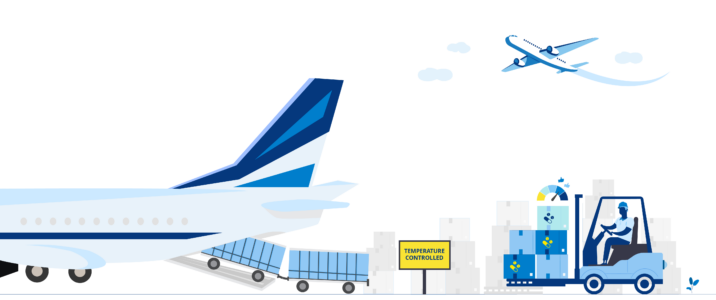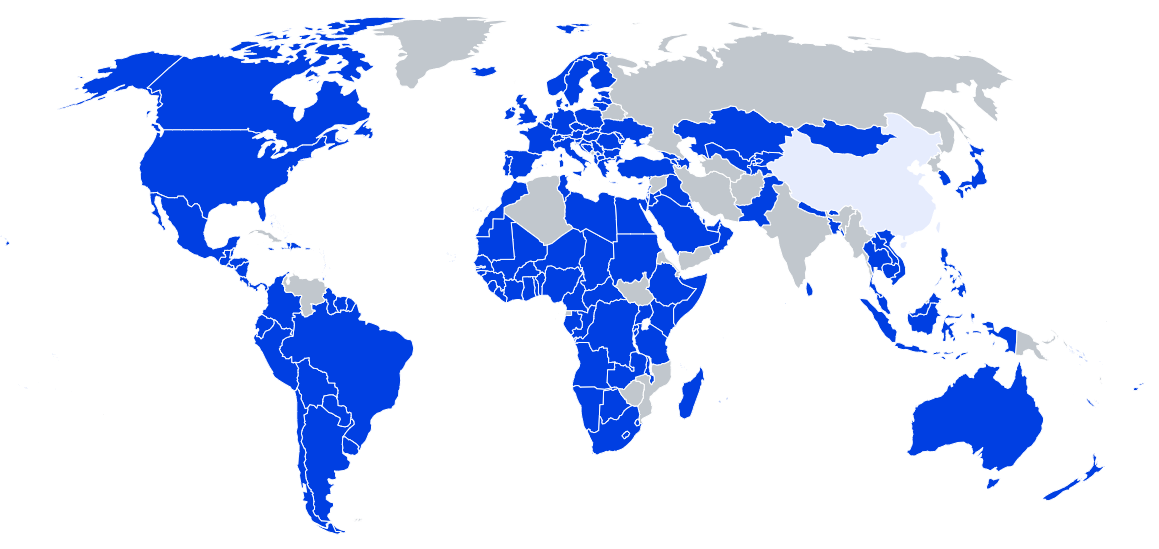Mastering Temperature-Controlled Shipping

Updated March 2024
Temperature-controlled shipping offers flexibility, making it possible to transport a wide range of products while maintaining their quality and safety. WebCargo gives freight forwarders the ability to digitally book temperature-controlled shipments across multiple airlines on a global scale.
The Role of Temperature-Controlled Logistics
Consider this: Since 2020, more than 4 billion Pfizer-BioNTech COVID-19 vaccine doses have been shipped worldwide. Without the possibility of shipping temperature-controlled goods, countries and continents across the world would not be able to receive this vital product.
Temperature-controlled shipping isn’t something new, but with the Covid-19 pandemic, it became a strong focus to ensure smooth operations and processes within air cargo.
Chart: Map of Pfizer-BioNTech COVID-19 vaccine shipments (Source)
This blog post explores the world of temperature-controlled shipping, and focuses on the features, benefits, and challenges this logistical leg faces.
Types of Temperature-Controlled Shipments
With a variety of products being moved both domestically and internationally by air, forwarders and airlines need to understand the type of temperature control required for the cargo to arrive in the same condition it was shipped.
When shipping temperature-controlled goods, passive and active regulation methods are two types of systems that cater to safe delivery.
- Passive Regulation: Utilizes insulated packaging and phase change materials (PCMs) or dry ice. This method maintains consistent temperatures without external power sources, which is better suited for shorter transit times.
- Active Regulation: Utilizes electronically-powered systems for cooling and heating to actively control temperature. This method is preferred for long-distance air cargo shipments, to ensure the container can hold a specific temperature range.
Goods Suitable for Temperature-Controlled Shipping
So what type of products actually utilize temperature-controlled shipping? Pharmaceuticals and perishable foods are the most well-known, but there is a wide range of goods that also require a specific temperature while transported.
The list below includes items that rely on temperature-controlled shipping:
- Pharmaceuticals – vaccines, biologic medicines, sensitive drugs
- Perishable Foods – seafood, fruits, vegetables, other fresh produce items
- Dairy Products – milk, cheese, ice cream, yogurt
- Floral Arrangements
- Chemicals and Biomedical Materials
- Electronics
- Cosmetics and Fragrances
- Chemical and Industrial Products – paints, coatings, solvents, adhesives
From high-priority pharmaceuticals to fresh produce to the latest electronics, temperature-controlled air freight is an essential part across many industries.
Temperature Ranges
Not all goods are created equally. Different goods have different needs when it comes to their temperature requirements.
The ability to transport goods at specific temperature ranges meets the evolving needs of many industries, and plays a pivotal role in the logistics chain.
The temperature levels available to book directly on WebCargo are:
- Frozen Storage (-10°C or below): Ideal for a wide variety of frozen products, from ice cream to frozen seafood.
- Chilled / Cool Storage (2°C to 8°C): Essential for fresh produce, dairy products, and certain pharmaceuticals like insulin.
- Extended Room Temperature (2°C to 25°C): Suitable for a broad range of goods, including electronics, cosmetics, some perishable foods and many pharmaceuticals.
- Controlled Room Temperature (15°C to 25°C): A narrower range within ERT, often required for the shipment of critical pharmaceuticals and chemicals.
Challenges and Solutions of Temperature-Controlled Shipping
Like any industry, temperature-controlled shipping faces its share of challenges. The air cargo industry is making strides towards ensuring successful deliveries, offering innovative solutions for greater reliability and safer temperature-controlled logistics.
Delays and Timing: For pharmaceuticals or perishables, time is often critical. To mitigate timing delays, forwarders use route planning to minimize layovers and take advantage expedite customs procedures, where possible. Selecting experienced carriers in temperature-controlled shipping can make a difference, as some offer expedited services.
Temperature Deviations: The risk of temperature deviations during transit can lead to costly product wastage and reduced effectiveness. Employing real-time monitoring systems and well-insulated containers with phase change materials (PCMs) can minimize these risks.
Regulatory Compliance: Adhering to regulatory requirements is non-negotiable, especially in the pharmaceutical industry. Compliance with Good Distribution Practices (GDP) and Good Manufacturing Practices (GMP) is essential. A comprehensive quality management system is a solution that helps maintain compliance. This system includes detailed record-keeping, regular audits, and well-documented Standard Operating Procedures (SOPs).
Security: Employing advanced security measures such as tamper-evident seals and GPS tracking can ensure the security of sensitive cargo during transit. Using trusted carriers with a strong track record in security can provide an added layer of protection.
Human Error: Despite technological advancements, human error can still pose a risk to temperature-controlled shipments. Ongoing training and education for personnel involved in handling and transporting these types of shipments are essential. Implementing standard operating procedures, checklists, and rigorous quality control measures can help minimize the risk of errors.
Environmental Impact: The air cargo industry is reducing its environmental impact through digitization, adopting energy-efficient technology and practices, like electric refrigeration, green packaging and using biofuels. WebCargo allows forwarders to filter their search to view which routes are the most eco-friendly, which optimizes flight routes to reduce carbon emissions.
Safely Transport Temperature-Controlled Goods with WebCargo
Temperature-controlled logistics is a dynamic field, with many factors coming into play like temperature range, shipping method and transit time. WebCargo aims to simplify this process for freight forwarders.
WebCargo allows freight forwarders to compare options, evaluate carrier expertise, and route assessment by providing real-time data and transparency, enabling them to select the carrier that best suits their specific requirements.
As of March 2024, the following carriers are available for temperature-controlled shipments through eBooking on WebCargo:
- Air France KLM Martinair Cargo
- Emirates SkyCargo
- Etihad Cargo
- IAG Cargo
- ITA Airways Cargo
- Lufthansa Cargo
- SAS Cargo
- TAP Air Cargo
- Qatar Airways Cargo
The Bottom Line
As experienced during the Covid-19 pandemic, temperature-controlled shipping is a lifeline for the pharmaceutical industry. It guarantees that vital vaccines, biologics, and sensitive drugs reach those in need while maintaining their efficacy.
As global commerce continues to grow, leading carriers partner with WebCargo to meet the rising demand for reliable temperature-controlled shipments.
If you’re a freight forwarder looking to ship pharmaceuticals, perishables, or any other type of temperature-sensitive goods, explore the WebCargo network of carriers that have temperature-controlled shipping options and start booking for free today.




